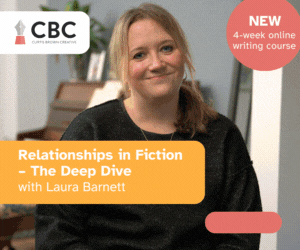Adrienne Chinn – Love In A Time Of War
20 March 2022
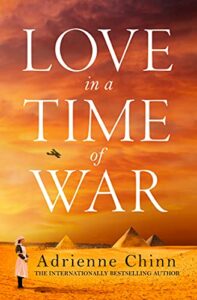 Your new book, Love in a Time of War, is coming out soon. The write-up looks full of drama and romantic angst. Please tell us more about it.
Your new book, Love in a Time of War, is coming out soon. The write-up looks full of drama and romantic angst. Please tell us more about it.
Love in a Time of War is the first book in a series of three, about the lives of three English sisters, Celie, Jessie and Etta Fry, during and just after the First World War. They are from a middle-class family in south London, with a father who runs a photography studio and an Anglo-Italian mother whom we learn more about in flashbacks to Capri in 1891-2, and who, we discover, hides a secret that she is determined will never be revealed. Celie, the eldest, works in the photography studio, is an ardent suffragist, and is in love with her German tutor, Max. Jessie, a fraternal twin with Etta, is stubborn and strong-willed, and, wishing to explore the world, joins up as an army nurse which brings her to Egypt. Etta is the flighty, romantic artist in the family who falls in love with a dubious Italian artist and runs away to Italy with him. We see through all their journeys, how the situations created by the war change their lives forever.
I’m currently editing Book 2 in the series which follows the sisters’ lives through the 1920s. Book 3 will run from 1935 to 1945 through the Great Depression and WWII.
What do you enjoy most about writing in the WWI time period? Where do you find inspiration for your characters?
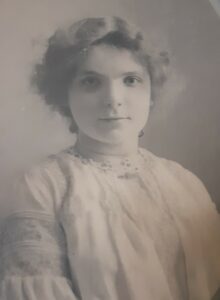 Both my grandfather’s family, the Chinns, and my grandmother’s family, the Frys, had keen photographers amongst them — my great-grandfather Frederick Fry was a court photographer for Edward VII — and I had access to a lot of family photographs from the late 1800s and early 1900s. Amongst these were photographs of my great-aunts Jessie and Ettie Chinn — Jessie who became a milliner was creative and engaged to a young German student who was killed during the war; Ettie joined the Queen Alexandra’s Imperial Nursing Service and served on a hospital ship at Gallipoli and in Egypt during the war. I have a photo of her in her nurse’s uniform sewing in a tent in Egypt. My grandmother, Edith Adelaide Fry Chinn, emigrated to Alberta, Canada with her British Army veteran husband and her two very small children in 1922 and never saw her English family again. I thought all of their stories were worthy of exploring, as they really show how women’s lives were so greatly affected by the war.
Both my grandfather’s family, the Chinns, and my grandmother’s family, the Frys, had keen photographers amongst them — my great-grandfather Frederick Fry was a court photographer for Edward VII — and I had access to a lot of family photographs from the late 1800s and early 1900s. Amongst these were photographs of my great-aunts Jessie and Ettie Chinn — Jessie who became a milliner was creative and engaged to a young German student who was killed during the war; Ettie joined the Queen Alexandra’s Imperial Nursing Service and served on a hospital ship at Gallipoli and in Egypt during the war. I have a photo of her in her nurse’s uniform sewing in a tent in Egypt. My grandmother, Edith Adelaide Fry Chinn, emigrated to Alberta, Canada with her British Army veteran husband and her two very small children in 1922 and never saw her English family again. I thought all of their stories were worthy of exploring, as they really show how women’s lives were so greatly affected by the war.
My mother’s family lost two young men — my great-uncles John and Alphonsus Edwards — in battles during WWI, and my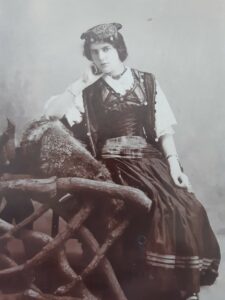 own grandfather, Thomas Chinn, was gassed with mustard gas and suffered a shrapnel wound which would eventually kill him in 1949. I’ve always been aware of the war through my family’s experiences, and I am a great history buff, having read English and History as an undergraduate. I enjoyed all the research about domestic life during the war, as well as the research about Gallipoli and the Italian front in the Dolomites. What interests me is how an individual responds to what is happening around them. I am interested in the human experience, and combining research and fiction writing has been the perfect way for me to explore what it is like to be human in a changing world.
own grandfather, Thomas Chinn, was gassed with mustard gas and suffered a shrapnel wound which would eventually kill him in 1949. I’ve always been aware of the war through my family’s experiences, and I am a great history buff, having read English and History as an undergraduate. I enjoyed all the research about domestic life during the war, as well as the research about Gallipoli and the Italian front in the Dolomites. What interests me is how an individual responds to what is happening around them. I am interested in the human experience, and combining research and fiction writing has been the perfect way for me to explore what it is like to be human in a changing world.
What is the one word that you overuse the most in your first draft? (If
you are like me, you have more than one word!)
So many! Nods, sighs, shrugs are my top 3 that I have to edit down (though not entirely out).
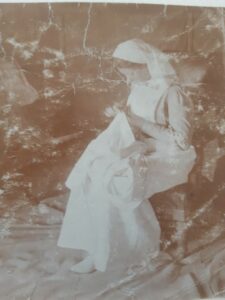 In 2011, you did the Faber course with Richard Skinner. How do you feel this helped you improve as a writer?
In 2011, you did the Faber course with Richard Skinner. How do you feel this helped you improve as a writer?
Absolutely! I’d always wanted to be a novelist. My mother said I was obsessed with pulling books off their bookshelves when I was a toddler and flipping through all the pages. She said my first word was “book” which I called milk. I’d done an MA in English Literature at university in Canada and worked as an editor for trade magazines for several years in Montreal before emigrating to the UK when I was 30. My father was English and I had dual nationality through him. I wanted a new adventure so decided to move to Britain where I ended up working as a freelancer in film and TV research for several years, after which I retrained as an interior designer and started my own business. About 10 years into working in interior design I sat down and wrote my first novel — the one which still sits in a bottom drawer of my desk. It didn’t go anywhere, but I felt encouraged that I could write a whole novel. When I turned 50 in 2010 I decided to take novel-writing really seriously. I applied to the “How to Write a Novel” course at Faber led by Richard Skinner and attended twice a week from January to June 2011. He was so clear in his teaching of the fundamentals of novel writing, and I really saw an improvement in my fiction writing. I began “The Lost Letter from Morocco” on that course, loosely inspired by my experiences in Morocco. It took 8 years of rewrites but it was eventually published by Avon UK in 2019, and I’ve been writing regularly since then.
Please share your journey to getting published with us. Where were you when you first heard about your very first publishing deal and how did you celebrate?
It took 8 years of rewrites on “The Lost Letter from Morocco” and a lot of rejections from agents in the UK, US and Canada, but it was eventually published by One More Chapter in 2019, as part of a 2-book deal. In those 8 years I took a huge number of night and weekend writing courses, attended the York Festival of Writing twice, the Winchester Writing Festival twice, and worked with an amazing writing mentor, Laurence King, who I found through Jericho Writers. Jericho Writers have been a wonderful resource all along the way, running many courses which I took, and also helping me find my agent, Joanna Swainson at Hardman & Swainson.
I was standing on platform 13 at Clapham Junction on a Friday afternoon in May, just before a Bank Holiday weekend, having taught that week. My phone pinged and there was a message from Avon UK. On advice of a writing friend I’d met on Richard Skinner’s course, who had gone on to have several psychological thrillers published by Avon, I submitted my novel to Avon directly rather than try to find an agent. This had been in February and I hadn’t heard anything. I’d had so many rejections by this point, I was expecting the same from this text. I began scrolling and reading — they apologised for the delay getting back … they received so many submissions … but, they’d all read the book and loved it and wanted to offer me a 2-book deal! I swear I nearly screamed and jumped for joy! I tried to call a few people but no one picked up … I took the train to my sister’s place in Sussex right away to tell her the news. I was thrilled!
What’s your favourite book about writing?
Take Off Your Pants by Libbie Hawker is fantastic for its guidance on plotting a novel. My copy is full of post it notes! I refer to it whenever I’ve working out my new novels. I also like On Writing by Stephen King and reading about his writing journey. Another favourite is Adventures in the Screen Trade by William Goldman, an Academy Award-winning Hollywood screenwriter, who does a terrific (and funny) dissection of screenplays, which has helped me a great deal in learning to craft tight and effective scenes with dialogue. I also follow writer Chuck Wendig’s blog Terribleminds in which he is irreverent, funny, and astute about writing.
You run retreats of your own. Please tell us more about these.
Before Covid I ran a 1-week design retreat in Marrakech (I have been working as an interior designer in London for 20 years), but I’ve had to cancel these the past couple of years. I’m keen to start up some writing/exploring retreats in Morocco in the future once things stabilise. Morocco is such an inspirational place — I’m always really productive when I’m there. I’ve been visiting Morocco about 4 times a year since 2007 and can’t wait to get back. I’ll post about any upcoming writing retreats on my website and social media.
What is your writing routine? Do you have a writing desk? Do you have
any writing rituals?
My typical writing day at home is this:
7:30 – Wake up, play Wordle, shower, coffee and porridge while playing Jewel Legend.
8:30 – 9:15 – Exercise
9:15 – 10:30 – Pfaff around — Tidy flat, read emails, play more Jewel Legend, etc.
10:30 – 1:30 – Write/edit. I go over what I wrote the day before, making any amendments, then continue from there. I usually write about 1,000 words a day.
1:30 – 1:45 – Lunch (very light — yogurt, cheese, fruit)
1:45-5:00ish – Write/Edit
5:00 – Finish for the day. Go for a walk, make supper, do some needlepoint as I watch Neflix, read, bed.
I do this 6 days a week if I’m not teaching (I teach interior design twice a week in London during term time). I never write at night — my brain doesn’t work then! I write in a green 1930s Lloyd Loom chair by my bedroom window with my laptop on a small portable lap desk. Notes are scattered around the floor and on my bed. When I’m travelling, I write anywhere — cafes, on friends’ sofas, tables or desks, by the pool, in the hairdressers!
If you could travel back to any period of time, when would you go back to and why?
Probably the 1960s. I was a kid then and I remember how vibrant and fun it was — I had a banana bike and pink and white polka dot bellbottoms and paisley cap and white boots, The Beatles were huge — I remember all the Yellow Submarine posters, magazines, lunchboxes, etc. when the movie came out. I’m a huge Beatles fan. There was so much energy around then and a feeling of a big new future ahead. I would have liked to be in my late teens/20s through all of that.
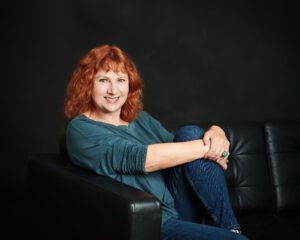 You can follow Adrienne here:
You can follow Adrienne here:
Website: www.adrienne-chinn.co.uk
Twitter: @adriennechinn
Facebook: Adrienne Chinn Author
Instagram: @adriennechinn
You can purchase her books here:
Amazon
Waterstones
Harper Collins
Adrienne has been speaking with:
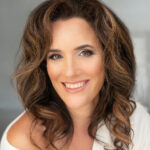
Julia Boggio is a writer, photographer, mother, Peloton lover, runner, and Christmas card enthusiast. She is also an original You Tube star. Her wedding dance went viral, sparking a worldwide trend in choreographed first dances. She and her husband appeared on The Oprah Winfrey Show, where she danced with Patrick Swayze, BBC Breakfast, Richard & Judy, Sky News, and many more. She has two cats who hate each other.


